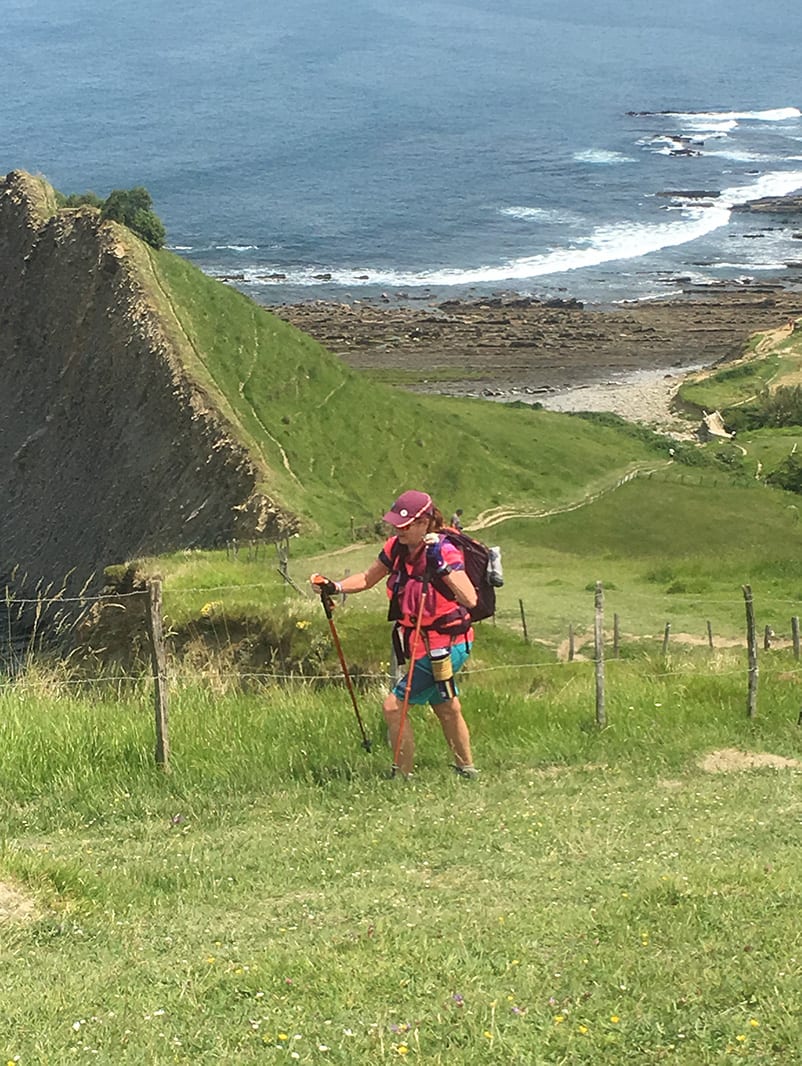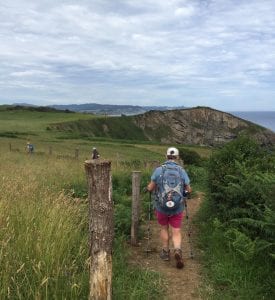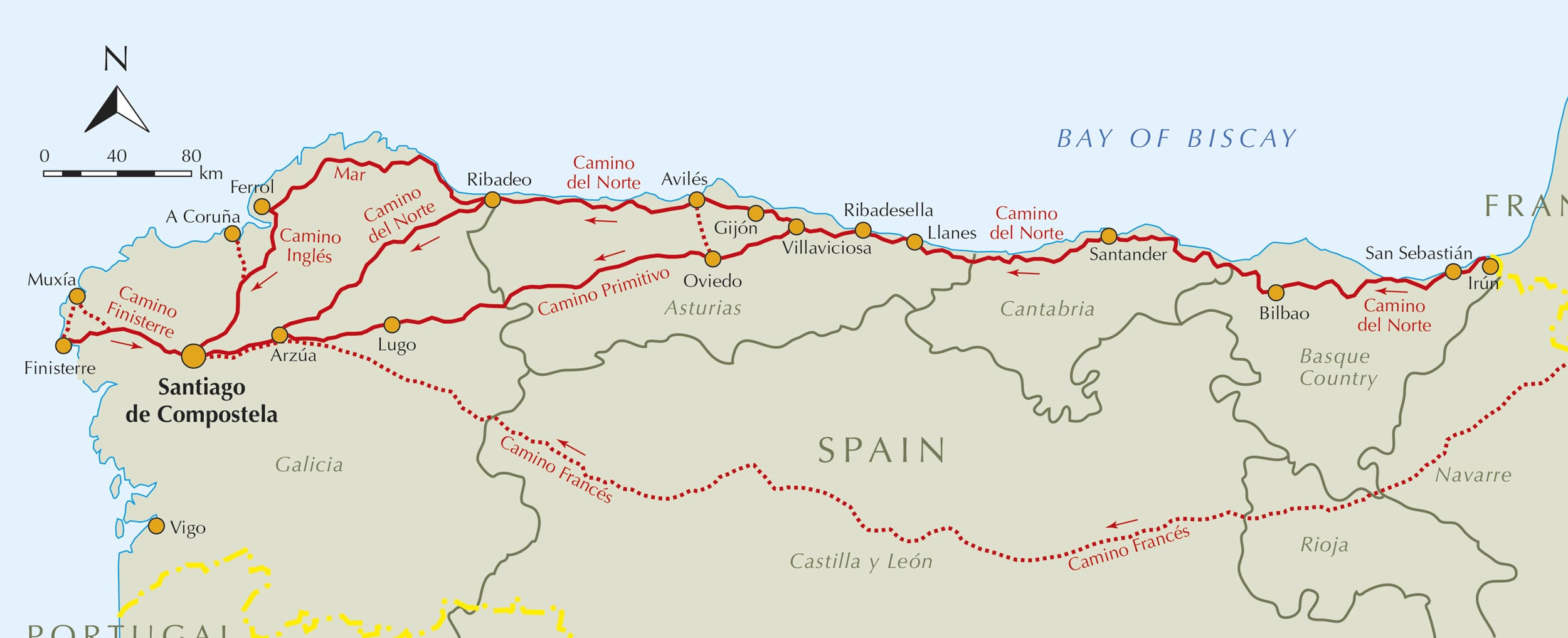Camino de Santiago: Camino del Norte (The Northern Way)
8 days / Self-guided walking
San Sebastian to Bilbao
Camino del Norte (The Northern Way)
Take on an 8-day section of the challenging yet beautiful Camino del Norte as it follows the Atlantic coastline from San Sebastian to Bilbao.
TRIP STYLE
DURATION/LENGTH
8 days/126 kms
DATES
Any date to suit you
START/END POINT
San Sebastian to Bilbao
GRADING
Challenging Walk
PRICE P/P TWIN SHARE
From EURO 760 / AUD 1,225

The Camino del Norte is known as one of the toughest and most rewarding Camino de Santiago routes a pilgrim can take. This 8-day section is a fantastic taste of the journey, taking in the foodie haven of beachside San Sebastian, Bilbao’s cultural institutions and all the charming fishing villages in between. You’ll have an opportunity to appreciate art in all its forms, from the natural to the manmade, while never being too far from the ocean. With fresh seafood, challenging terrain and a refreshing swim waiting for you at the end of each day, the Camino del Norte is an experience you won’t forget anytime soon.
Day 1 | Arrive San Sebastian
The Camino del Norte technically begins in Irun, but we highly recommend arriving in San Sebastian and either starting here or adding an extra night to take the train north to Irun and walk back south into San Sebastian. It’s a great path to warm up your walking muscles before the toughest section of the walk from San Sebastian to Bilbao.
The reason we suggest arriving in San Sebastian is that it is one of our favourite cities in all of Spain. Located in the Basque Autonomous Community, San Seb – as it’s known – is hugged by two stretches of golden sand and surrounded by lush green hills. It’s a popular surfing destination and the restaurants are famously good. The Old Town’s maze of alleyways hosts some of the best pintxos (the Basque version of tapas) restaurants in Spain, which also serve a draught local cider that will knock your hiking socks off. Combine this with the stunning architecture matched by the seaside sunsets, San Seb is a place we will always hold dear in our hearts.
Optional Day | Irun – San Sebastian | 24 km / 7 hours
Take the train north to Irun, a small town located on the Spanish-French border. This is a difficult but spectacular start to your Camino del Norte experience and the views are well worth the uphill climb. It’s a great opportunity to find your walking rhythm and you’ll be duly rewarded with a swim and a tasty meal once you arrive in San Sebastian. We suggest rewarding yourself with a piece of the world’s best cheesecake. It’s also worth stopping along the way at Passajes de San Suan for lunch, a charming fishing village, before taking the small boat shuttle across the water to continue your Camino.
Day 2 | San Sebastian – Getaria | 26 km / 7 hours
The crescent-shaped Playa de la Concha is often referred to as the most beautiful city beach in Europe and it’s here from here that you’ll say goodbye to San Sebastian. You’ll follow the Camino’s comforting yellow arrows out of town and tackle the first of the ascents and descents that define the Camino del Norte. As the path follows the coastline south you’ll find yourself walking across rolling green hills and over headlands to reach the small fishing towns dotted along the way.
Getaria has a small population of just under 3000 and is the hometown of Juan Sebastian Elcano, the first man to circumnavigate the world, who became captain of Ferdinand Magellan’s voyage after he was killed in the Philippines. It’s also the hometown of fashion designer Cristobal Balenciaga, who has a museum dedicated to his work. If fashion isn’t your thing, the waterfront area is a great spot to relax and enjoy a few plates of pintxos with a view.
Day 3 | Getaria – Deba | 18 km / 5 hours
Today’s walking is a nice balance of pretty beach towns, expansive sea views and, of course, hills. There is an option to take a higher or lower path and, if the weather is good, it’s worth taking on the high path to enjoy the spectacular views of the rugged Atlantic coastline. A small but pretty town that’s popular during the summer, Deba has some nice places to eat and drink a welcoming stretch of sand to soak up the afternoon sun. The town’s backdrop is absolutely stunning and typical of the towns and cities along the Basque coast.
Day 4 | Deba – Markina | 24 km / 6–7 hours
Perhaps enjoy a morning swim before heading inland from the coast to climb Collado de Arno, a tough ascent surrounded by densely forested hills. As you almost certainly know by now, the rewards along the Camino del Norte are worth the effort and Markina is a lovely place to experience, and more importantly taste, the Basque people’s passion for their local cuisine.
The town also boasts a strong connection with the Basque sport of ‘pelota’, a squash-like sport that has been played since the 13th century. The town’s main court is known as the University of Pelota as a sign of respect of the connection. Another point of interest is the Church of Santa Maria, constructed in the Gothic style typical of the 16th century, which features a magnificent altarpiece.
Day 5 | Markina – Gernika | 25 km / 6–7 hours
Today you’ll walk past the picturesque Monasterio Zenarruza, which was first built as a church around the 10th century. Since 1988 it has been a Trappist monastery and yes, that means the monks brew their own beer, which you may be able to try and purchase on your way through. While this is no doubt a highlight, the town of Gernika – today’s final destination – is one of the most historically significant towns on the Camino del Norte.
Gernika is best known around the world for its 1937 bombing conducted by the Nazi Luftwaffe at the behest of General Franco, Spain’s ruthless dictator, as part of his attempt to overthrow the regional government. The horrific event, in which an estimated 1600 civilians were killed, was immortalised by Picasso in his painting ‘Guernica’, which now hangs at the Reina Sofia in Madrid.
Gernika is known as a town of peace as well as a stronghold of Basque identity. The tree of Gernika sits on a hillside above the town, under which generations of kings and leaders have sworn to protect the culture, people and independence of the Basque community.
Day 6 | Gernika – Lezama | 21 km / 5 hours
After uncovering the streets and history of Gernika, the physical ups and downs of the Camino del Norte continue before reaching the town of Lezama. This is an ideal resting place to shorten what would be a very long and difficult stage through to Bilbao. Your accommodation tonight is one to remember, with a 400-year-old history and vineyards surrounding the property. The hosts offer a special dinner on most nights – we can confirm that roast chicken has never tasted better – which is the perfect way to spend your final evening on the Camino del Norte before walking to Bilbao.
Day 7 | Lezama – Bilbao | 15 km / 3–4 hours
Today is a much easier walking day and you’ll enjoy spectacular views of Bilbao, its surrounding mountains and the deep river valley it calls home. On the way into town you’ll walk past the Basilica of Our Lady of Begona, which features stunning architecture and has a fascinating legend surrounding its origin.
Bilbao is the de facto capital of the Basque Autonomous Community and an ideal way to end this first stage of the Camino del Norte. It’s famous for the Frank Gehry-designed Guggenheim Museum, which was opened in 1997 and consequently sparked a revitalisation of the city.
Bilbao is now a popular tourist destination and a cultural hotspot with world-renowned dining options, beautiful landscapes and a truly cosmopolitan buzz about it. We highly recommend going for a pintxos (tapas) crawl through the market square and trying the spider crabs – utterly delicious. If seafood isn’t your thing, there are so many other options and it’s definitely worth spending a few days exploring the city and eating absolutely everything.
Day 8 | Finish in Bilbao
This first stage of the Camino del Norte comes to an end in Bilbao, as does your pilgrimage – for now. You’ll find that even though you’ve walked a small section of the Camino, the relationships you’ve formed will last a long time and we hope that you’ll be back to Wander the World – or at least the rest of the Camino del Norte – with us in the future. Buen Camino!
Visit www.wanderingtheworld.com.au for more information.
Inclusions
- 7 nights accommodation, all carefully selected to enhance your Camino experience
- Private en-suite facilities
- Daily luggage transfers from hotel to hotel (1 x 20kg bag unless indicated otherwise)
- Daily breakfast
- Information packs with route maps and instructions on how to locate hotels
- Luggage identification tags
- Pilgrim’s passport
- Emergency contact details and 24/7 local on-the-ground support
- Pre-departure and ongoing support from Australian office
- Guidebook
Optional Inclusions
- Three-course dinners with local wine
- Suggested rest days as outlined in itinerary or if required
- Upgraded accommodation including paradors, country properties and premium/high-end styles
- Private vehicle transfers to the trip’s starting point
- Single supplement for your own room
- Additional night’s accommodation before or after trip (please advise at time of booking)
Not Included
- Flights
- Travel to trip’s starting point
- Transfers not already outlined in detailed trip itinerary
- Lunches
Accommodation
We know from personal experience that a good night’s rest can make or break a trip, which is why we carefully hand-select all our accommodation. We ensure that our knowledge and firsthand experience of the best places to stay is passed on to all our walkers.
Your accommodation along the Camino is booked in advance, on a twin-share basis with private facilities, and chosen to make your pilgrimage experience as rewarding as possible. You may be staying in a refurbished farmhouse, some of which have been in the same family for centuries, or perhaps a boutique hotel with a chef who would not be out of place in a Michelin-starred restaurant. There are unique properties scattered throughout the different routes including converted monasteries, lighthouses and tiny B&Bs with the most generous hosts you could possibly imagine. Best of all, you’ll always have private en-suite facilities. Wherever you end up, you’ll be well looked after, warm and comfortable and, most importantly, ready to tackle the next day’s walk.
Single supplements are also available so you can enjoy your room with private en-suite. This supplement will apply if you are travelling alone or if there is no gender-share option. You can request a shared room through Wandering the World at the time of booking, however this is not guaranteed.
There are opportunities to upgrade to more luxurious lodgings in many places along the Camino. These are perfect for celebrating special occasions and milestones, or even to enhance your entire journey. We can recommend some very special, unique places to indulge in the Camino hospitality in spectacular style, so please ask us about these options when booking.
Food & Dining
The local cuisine is a definite highlight of your walk. The Camino regions are famous for their culinary delights, and you’ll end up exploring the destination using not only your feet, but also your taste buds.
Breakfast at your place of accommodation is usually continental style and may include cereals, yoghurt, bread, pastries, ham, tea, coffee and juices.
Lunch – at your own expense – will depend on where you are on your walk and what is available. It’s often purchased at a local café or bar, with choices along the trail perhaps including Spanish omelette (tortilla Espanola), tuna empanadas, soups or sandwiches (boccadillo). Alternatively, you may wish to enjoy a picnic in a perfect spot along the path.
Evening meals are a hearty, three-course affair known as the ‘pilgrims’ menu’. These usually consist of a salad or soup to start, followed by a choice of a meat or pasta dish, then finishing with a dessert. This is always accompanied by a bottle of local wine, of course. On occasion, the owner of the accommodation may be in the kitchen preparing the house special, which will not disappoint.
Most evening meals are included on guided group trips, and for self-guided itineraries, Wandering the World can include as many evening meals as you wish. We may strongly recommend this in some places because it’s either been a long walking day or there are limited choices available in certain destinations. We can share our advice and talk to you about this at the time of booking. We can accommodate most dietary requirements, so please let us know in advance.
THE WALKING
This trip is a self-guided itinerary, ideal for groups and independent travellers who prefer to navigate in their own way and their own time.
You will be provided with an information pack including easy-to-read maps and instructions, complete with directions to guide you on the well-marked paths and tracks. On the Camino, you will be following the yellow arrows and Camino scallop shells, while the Chemin is marked with red and white stripes. This information pack will be available at your joining hotel on the first day of your trip.
TRIP GRADE
Challenging – This itinerary is carefully designed for easy-to-manage walking days that generally average less than 20 km, or approximately 4–6 walking hours. The surfaces are fairly even with moderate ascents and descents. A reasonable level of fitness is recommended.
Given you only need carry a lightweight day pack, this trip is very manageable for those who are new to walking holidays. Whatever your previous experience, preparation and training make all our walks more enjoyable.
LUGGAGE TRANSFERS
Wandering the World arranges a daily luggage transfer to maximise your comfort and enjoyment, so all you need to carry is a day pack. Luggage allowance is one bag per person of no more than 20 kg (13 kg on the Chemin). Your luggage must be left in the reception of your hotel before breakfast (8 am) each day.
Please note:
- It is essential to attach the bag tag provided to ensure your luggage is delivered to your next accommodation.
- Only one bag will be moved each day and additional charges will apply if your bag is heavier than 20 kg (13 kg on the Chemin).
- Should you require special arrangements for additional luggage transfers, these can be made ahead of time and must be paid as part of your final payment to Wandering the World.
GROUP SIZE
Wandering the World’s guided groups have a maximum group size of 12 participants. This small group size means that we have the flexibility to stay in a wider range of accommodations, can dine together in the evenings, have the freedom to walk alone or together, and there are more opportunities to get to know your travelling companions.
TRANSFERS/TAXIS
If, for any reason, you wish to shorten your walking day, there are options along the Camino and in the villages to arrange a taxi.
On some itineraries, there are times when Wandering the World may arrange a transfer for you or can do so at your request. This might happen where small villages do not have accommodation with private facilities, for example, or when we want to take you to a special country property that we know you are going to love. In this case, Wandering the World will either arrange a transfer for you or suggest a taxi.
Transfers on the Camino are common in parts. A simple procedure is outlined in your trip notes explaining the details of your private transfer, the designated meeting point and the agreed transfer time.
WEATHER
The weather and climate on the Camino can vary from country to country, region to region and, of course, from day to day. Each season has its own benefits, with long, warm and sunny days in spring and early summer, while early spring and late autumn tend to enjoy cooler walking temperatures. Some sections may be too hot for walking mid-summer, while others are more likely to be wet at certain times. The experts at Wandering the World can discuss your preferences and guide you when you are planning your trip.
Once you’ve started your walk, the weather can play an important role in your overall enjoyment of the journey. Checking the forecast can be a great help when planning your days. If you do strike hotter weather, leaving early to avoid the warmest part of the day will make a huge difference.
24/7 SUPPORT & CARE
Your information pack will include details of local emergency contacts and international contacts. We have local, on-the-ground support to provide any assistance you may require and we’ll also check-in with your hotel at the end of each day to ensure that you’ve arrived safely.
GETTING THERE / GETTING HOME
This itinerary begins in San Sebastian and ends in Santiago de Compostela.
The closest airports to San Sebastian are Barcelona, Biarritz or Bilbao.
From your airport of choice there are bus, train and flight options as per the links below.
Train bookings are recommended. Please note you can only book two months in advance of the date of travel.
Bus: ALSA
Train:
Bus/Train : Rome2Rio
Flights:
Also, check out: Skyscanner OR Spanish Airport Guide
INSURANCE
Insurance is compulsory for everyone who travels with Wandering the World. The insurance policy must include cover against personal accident, medical expenses, emergency repatriation and personal liability. Wandering the World recommends insurance coverage for cancellation to be taken at the same time your deposit is paid, as no exception to the cancellation provisions can be made.
BOOKING AND TRAVEL TERMS AND CONDITIONS
Wandering the World’s full booking terms and conditions are available upon request and will also accompany your initial invoice for deposit.
 “The section from San Sebastian to Bilbao, was a fabulous challenge that I immensely enjoyed, without question the toughest week of any of my 24 Caminos. The up and down was gruelling in parts, which also made the journey more rewarding. Along with the undeniably stunning scenery, the hospitality in the country properties with all the home cooked basque food was just what was needed at the end of a big day walking these coastal paths. Not for the faint hearted, with all the ups and downs this section of the Camino del Norte was a fabulously dramatic walk of enjoyment!” – Glenyce, Founder of Wandering the World.
“The section from San Sebastian to Bilbao, was a fabulous challenge that I immensely enjoyed, without question the toughest week of any of my 24 Caminos. The up and down was gruelling in parts, which also made the journey more rewarding. Along with the undeniably stunning scenery, the hospitality in the country properties with all the home cooked basque food was just what was needed at the end of a big day walking these coastal paths. Not for the faint hearted, with all the ups and downs this section of the Camino del Norte was a fabulously dramatic walk of enjoyment!” – Glenyce, Founder of Wandering the World.

